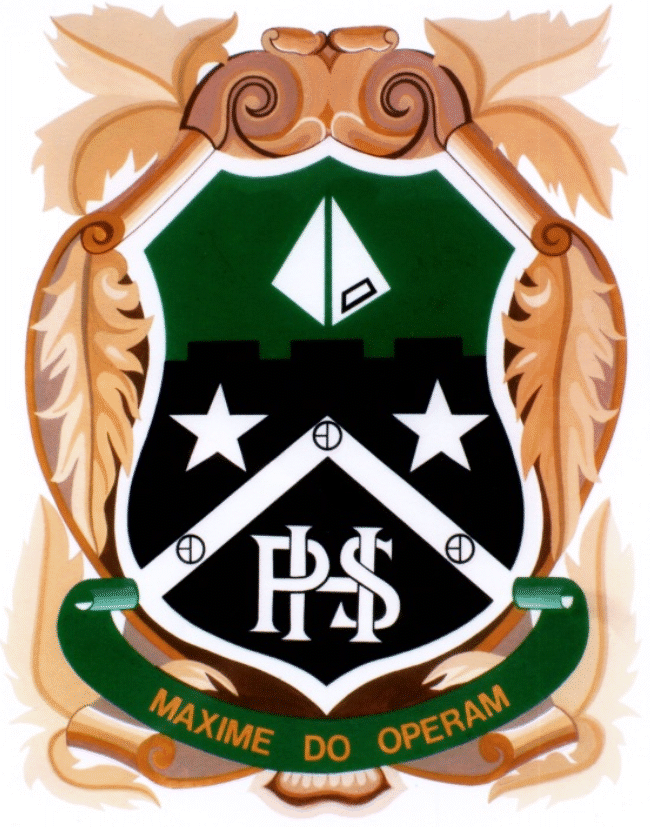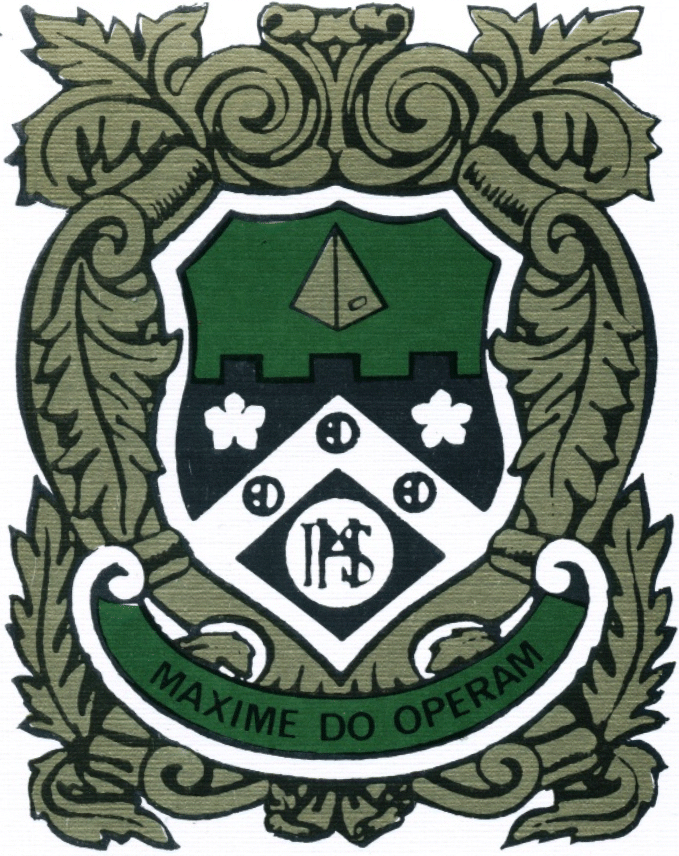

PEARSON HIGH SCHOOL / HOËRSKOOL PEARSON, Summerstrand, Port Elizabeth.

Arms registered by the Bureau of Heraldry on 30 October 1967. The current certificate is a duplicate issued since 1976, the original having been lost in one of the two fires that destroyed much of the school’s memorabilia during the 1970s. The arms are blazoned:
Arms: On a shield fringed Argent and with exterior decorations Or, Sable, the upper side embattled, a chevron Argent charged with three buckles, oval-shaped and the tongues thereof pointing fesswise to dexter, between two molets Argent; on the lower division the letters P.H.S. Argent arranged as a monogram. In chief Vert a representation of a pyramid, Argent. For a motto, on a scroll Vert, in letters Or: MAXIM DO OPERAM.
A corrected blazon can be found on the database of the National Archives. It reads:
Arms: Sable, on a chevron, between in chief two mullets and in base the monogram P.H.S. Argent, three oval buckles, tongues fesswise to dexter, and on a chief embattled Vert a pyramid arraswise, the whole within a bordure Argent.
Motto: MAXIME DO OPERAM.
The motto is misspelled on the certificate, as the illustration clearly shows the wording to be Maxime do operam. However, since in heraldic law the wording is taken as definitive, and the illustration merely additional, it would seem as if the school is entitled to request a re-issue of the certificate.
It is unusual in British and South African heraldry for the colours of a motto scroll to be specified. This is more common in Dutch usage.
About the arms:
Curiously, the arms as registered have less in common with the arms of Sir Rufane Donkin, founder of Port Elizabeth, and of the City of Port Elizabeth, than the badge the school used until the time of registration.

The colours are of the school’s choosing, and bear no relation to the Donkin arms, which feature a silver chief and chevron on red, and gold charges on the main field.
But the chevron, the buckles and the embattled chief are taken from Sir Rufane’s family device – the buckles are even aligned as in the arms of the city’s founder, rather than vertically, as in the city arms – while the cinquefoils characteristic of the Donkin arms and those of the city have been substituted with mullets (or five-pointed stars), which here are blazoned with the old-fashioned spelling molet.
There are two deliberate changes (aside from the colours) in the original school badge. These are:
a) The substitution of the pyramid for the Indian elephant that (together with the embattled chief) was an augmentation of honour to Sir Rufane’s arms in recognition of his services in India.
b) The use of the letters PHS in place of the bugle horn that appears in the base of Sir Rufane’s arms.
The structure in the chief is not an Egyptian pyramid, but has a sharper angle, since it represents the monument to Sir Rufane’s wife Elizabeth, née Markham, which was erected on the Donkin Reserve, the open space which he proclaimed on the high ground overlooking the harbour of Port Elizabeth.
This was in the style of a number of pyramids in these proportions erected as memorials in the late 18th and early 19th centuries at various sites across Western Europe, from Italy to Britain.
The inclusion of the pyramid in the arms recalls the school’s second home, the Grey Institute building in Belmont Terrace, which overlooks the Donkin Reserve.
The same pyramid (differently coloured) also appears in the arms of Livingstone Hospital and Lawson Brown High School.
The letters appeared in the original badge in black on a white roundel. This is actually a surprising inclusion on the part of the State Herald, since heraldry does not normally tolerate the use of text-letters.
The current blazer badge displays both the pyramid and the text-letters incorrectly, the pyramid appearing in black on green, and the letters in green on black.
These errors in the blazer badge are that much more surprising in view of the fact that the arms were registered in the school’s name all of four decades ago.
The school does not explain the derivation of the decorative background, which is drawn slightly differently in the old badge from the style used in the registered arms, but it resembles ornamental stonework.
The motto translates as: “I do my best.”
About the school:
Pearson High School as it exists today is a dual-medium (Afrikaans- and English-medium) co-educational high school teaching pupils from Grades 8 to 12 (previously Std 6 to Std 10). Its premises in Jenvey Road, Summerstrand, are the school’s fourth home.
In 1925 Port Elizabeth had five high schools, two of them under the control of the Port Elizabeth School Board, and 12 primary schools, nine of them under the board. The high schools were all sexually segregated, and until the 1920s all taught exclusively in English.
The high schools also charged fees that many parents found excessive. The result was that many pupils left school with only a primary school education.
Language Ordinances passed in 1920 and ’25 made it permissible for pupils to be educated in their own mother tongue up to Std 6 (then part of the primary school system), and two primary schools began additionally teaching in Afrikaans. Parents in Port Elizabeth began putting pressure on the School Board to provide secondary education more cheaply, and also in Afrikaans.
The School Board arranged for a new secondary school for boys and girls, initially teaching only in English, to be established, and in December appointed Mr L P V Deary as principal.
The new school was to share the old hospital building in Richmond Hill with the Central Primary School, and opened in January ’26. Starting with Std 7 pupils, it first added the Junior Certificate (Std 8) to its curriculum, and in 1929 the first class of Senior Certificate pupils matriculated, three of them attaining first class passes.
One pupil passed the 1927 Junior Certificate examination with Afrikaans Higher.
In 1928 12 pupils who had been taught in Afrikaans up to Std 6 applied for admission, and 10 of them were admitted to a mixed-language class – the beginning of dual-medium teaching at the school. In the 1929 Junior Certificate 10 pupils (probably these same 10) took Afrikaans Higher.
The 1929 Senior Certificate saw four pupils pass with Afrikaans Higher – the first pupils in Port Elizabeth to pass Afrikaans as a matriculation subject. This developed until in 1938 an entire Std 10 class wrote the Senior Certificate in Afrikaans. One of them, Antoinette Mattheus, won the Municipal Gold Medal.
Curiously, Mr Deary initially segregated the girls from the boys in Std 7, only mixing the more senior classes.
The school – up to this time called Port Elizabeth Secondary – moved in July 1927, since rooms at the Grey Institute building in Belmont Terrace had become available following the departure of the Collegiate Junior School. However, parts of the complex were still occupied by older schools: Collegiate Senior used the old Rectory as a hostel, while Grey Junior School still used the northern section.
Mr Deary proposed that the school be named the Lady Elizabeth Donkin School,[1] but the School Board chose to name it, from January 1928, after the Hon William Pearson, who had served as a municipal commissioner in 1859 and ’60, and as a town councillor from 1860 to ’95. During that time he was mayor for a total of 16 years.
The school’s accommodation was improved in 1930 when the Collegiate girls moved out of the old Rectory and the Grey Junior boys left the classrooms on the north side, leaving Pearson High in possession of all the classrooms in the complex, and Mr Deary in residence at the Rectory.
But it was clear that even more accommodation was required – even the hall had to be subdivided with partitions into classrooms – and Mr Deary pressed the School Board for a permanent home.
The municipality granted a site in Bayview Avenue, in the Hospital Endowment (later known as Way Township, and now called Mount Croix), which Mr Deary found highly suitable.
In 1932 the board agreed to the school’s moving, but the municipality withdrew its offer and no agreement on a site was reached until 1940, when the municipality (for the second time) granted the Bayview site for education.
Mr Deary had by this time become inspector of education in Vryburg, and travelled down to lay one of the two foundation stones, the other being laid by Ds D L Steyl.
The new school building was inaugurated in August 1941, the entire school marching in fours, led by banner-bearers and followed by a brass band, from Belmont Terrace to Bayview Avenue.
In 1950 the school unveiled a war memorial plaque bearing the names of 31 past pupils who had died serving in the Second World War. Remembrance Day became an annual event on the school calendar.
When in 1954 Std 6 was included in Port Elizabeth’s high schools for the first time, Pearson was already the largest high school in the Eastern Province.
The 1970s saw the school suffer two devastating fires. The school’s enrolment had also risen to more than 800, and it was felt that larger premises were needed. In the light of the cost of refurbishing the Bayview Avenue premises, and there being no space for further expansion there, the School Board decided that a planned school in Summerstrand, at the southern end of the city’s Algoa Bay side and close to the University of Port Elizabeth, would become the new home of Pearson High.
In the school’s gold jubilee year, 1976, it opened in Jenvey Road.
All Cape Education Department schools had been racially segregated from their establishment, and many parents found this increasingly unsuitable. The parent body was polled, giving the school the green light to choose Model B, and it opened to pupils of all races in January 1991.
The following year, 1992, Pearson became the first co-educational high school in the Cape Province to have a female head when Miss Daphne ffolliott became principal. Her taking over also coincided with the school’s switch from Model B to Model C. See here for more about Model B/C.
Website:
The school has its own website here.
